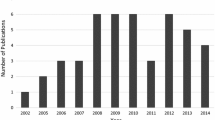Abstract
Computational and mathematical methods arguably have an enormous potential for serving practical needs in crime analysis and prevention by offering novel ideas and tools for crime investigations as well as experimental platforms for decision support in evidence-based policy making. We present here a comprehensive computational framework for modeling of criminal behavior to facilitate systematic experimental studies of a wide range of criminal activities in urban environments.
Preview
Unable to display preview. Download preview PDF.
Similar content being viewed by others
References
Brantingham, P.J., Brantingham, P.L.: Patterns in Crime. Macmillan Publishing Company, New York (1984)
D’Amico, J.: Stopping Crime in Real Time. The Police Chief – The Professional Voice of Law Enforcement (July 2008), www.policechiefmagazine.org/magazine
Liu, L., Eck, J. (eds.): Artificial Crime Analysis Systems: Using Computer Simulations and Geographic Information Systems. Information Science Ref. (January 2008)
Groff, E., Birks, D.: Simulating crime prevention strategies: A look at the possibilities. Policing: A journal of Policy and Practice 2(2), 175–184
Brantingham, P.J., Brantingham, P.L., Glässer, U.: Computer Simulation as a Research Tool in Criminology and Criminal Justice. Criminal Justice Matters (58) (February 2005)
Brantingham, P.L., Kinney, B., Glässer, U., Jackson, P., Vajihollahi, M.: Mastermind: Computational Modeling and Simulation of Spatiotemporal Aspects of Crime in Urban Environments. In: Liu, L., Eck, J. (eds.) Artificial Crime Analysis Systems: Using Computer Simulations and Geographic Information Systems. Information Science Reference (2008)
Brantingham, P.L., Glässer, U., Kinney, B., Singh, K., Vajihollahi, M.: A Computational Model for Simulating Spatial Aspects of Crime in Urban Environments. In: Jamshidi, M. (ed.) Proceedings of the 2005 IEEE International Conference on Systems, Man and Cybernetics, pp. 3667–3674 (October 2005)
Brantingham, P.L., Glässer, U., Kinney, B., Singh, K., Vajihollahi, M.: Modeling Urban Crime Patterns: Viewing Multi-Agent Systems as Abstract State Machines. In: Proc. of 12th Intl. Workshop on Abstract State Machines (ASM 2005) (March 2005)
Xue, Y., Brown, D.: A decision model for spatial site selection by criminals: a foundation for law enforcement decision support. IEEE Transactions on Systems, Man, and Cybernetics, Part C: Applications and Reviews 33, 78–85 (2003)
Felson, M.: Routine Activities and Crime Prevention in the Developing Metropolis. Criminology, 911–931 (1987)
Börger, E., Stärk, R.: Abstract State Machines: A Method for High-Level System Design and Analysis. Springer, Heidelberg (2003)
Farahbod, R., Gervasi, V., Glässer, U.: CoreASM: An Extensible ASM Execution Engine. Fundamenta Informaticae, 71–103 (2007)
Farahbod, R., Glässer, U., Jackson, P., Vajihollahi, M.: High Level Analysis, Design and Validation of Distributed Mobile Systems with CoreASM. In: Proceedings of 3rd International Symposium On Leveraging Applications of Formal Methods, Verification and Validation (ISoLA 2008) (October 2008)
Stärk, R., Schmid, J., Börger, E.: Java and the Java Virtual Machine: Definition, Verification, Validation. Springer, Heidelberg (2001)
Farahbod, R., Glässer, U., Vajihollahi, M.: An Abstract Machine Architecture for Web Service Based Business Process Management. International Journal of Business Process Integration and Management 1, 279–291 (2007)
Glässer, U., Gotzhein, R., Prinz, A.: The Formal Semantics of SDL-2000: Status and Perspectives. Computer Networks 42(3), 343–358 (2003)
Beierle, C., Börger, E., Durdanovic, I., Glässer, U., Riccobene, E.: Refining Abstract Machine Specifications of the Steam Boiler Control to Well Documented Executable Code. In: Abrial, J.-R., Börger, E., Langmaack, H. (eds.) Dagstuhl Seminar 1995. LNCS, vol. 1165, pp. 62–78. Springer, Heidelberg (1996)
Glässer, U., Gurevich, Y., Veanes, M.: Abstract Communication Model for Distributed Systems. IEEE Trans. on Soft. Eng. 30(7), 458–472 (2004)
Glässer, U., Gu, Q.P.: Formal Description and Analysis of a Distributed Location Service for Mobile Ad Hoc Networks. Theoretical Comp. Sci. 336, 285–309 (2005)
Jensen, O., Koteng, R., Monge, K., Prinz, A.: Abstraction using ASM Tools. In: Prinz, A. (ed.) Proc. of the 14th International ASM Workshop (ASM 2007) (2007)
Bratman, M.E., Israel, D., Pollack, M.E.: Plans and Resource-Bounded Practical Reasoning. Computational Intelligence 4, 349–355 (1988)
Brantingham, P.L., Glässer, U., Jackson, P., Vajihollahi, M.: Modeling Criminal Activity in Urban Landscapes. Technical Report SFU-CMPT-TR-2008-13, Simon Fraser University (August 2008)
Dijkstra, E.W.: A Note On Two Problems In Connection With Graphs. Numerische Mathematik 1, 269–271 (1959)
Author information
Authors and Affiliations
Editor information
Editors and Affiliations
Rights and permissions
Copyright information
© 2008 Springer-Verlag Berlin Heidelberg
About this paper
Cite this paper
Glässer, U., Vajihollahi, M. (2008). Computational Modeling of Criminal Activity. In: Ortiz-Arroyo, D., Larsen, H.L., Zeng, D.D., Hicks, D., Wagner, G. (eds) Intelligence and Security Informatics. EuroIsI 2008. Lecture Notes in Computer Science, vol 5376. Springer, Berlin, Heidelberg. https://doi.org/10.1007/978-3-540-89900-6_7
Download citation
DOI: https://doi.org/10.1007/978-3-540-89900-6_7
Publisher Name: Springer, Berlin, Heidelberg
Print ISBN: 978-3-540-89899-3
Online ISBN: 978-3-540-89900-6
eBook Packages: Computer ScienceComputer Science (R0)




